Analysis of HR Professional Development and Learning Report
VerifiedAdded on 2020/07/22
|13
|3727
|36
Report
AI Summary
This report examines the multifaceted aspects of HR professional development, organizational learning, and their impact on sustainable business performance. It begins by outlining the essential knowledge, skills, and behaviors required of HR professionals, emphasizing the importance of continuous learning. The report then analyzes a personal skills audit for an HR officer, Jane Cambridge, identifying specific training and development needs, and subsequently creates a detailed professional development plan to address these needs. A key section contrasts organizational and individual learning, along with training versus development, highlighting their interconnected roles in fostering a high-performance culture. The report concludes by underscoring the necessity of continuous learning and professional development to drive sustainable business performance, emphasizing the dynamic nature of the HR field and the importance of adapting to evolving workplace demands. The report also includes tables detailing the development objectives, activities, support resources, target dates, and evaluation methods for the HR officer's development plan. Finally the report emphasizes on the difference between training and development. The report is available on Desklib, a platform that provides AI-based study tools and resources for students, including past papers and solved assignments.
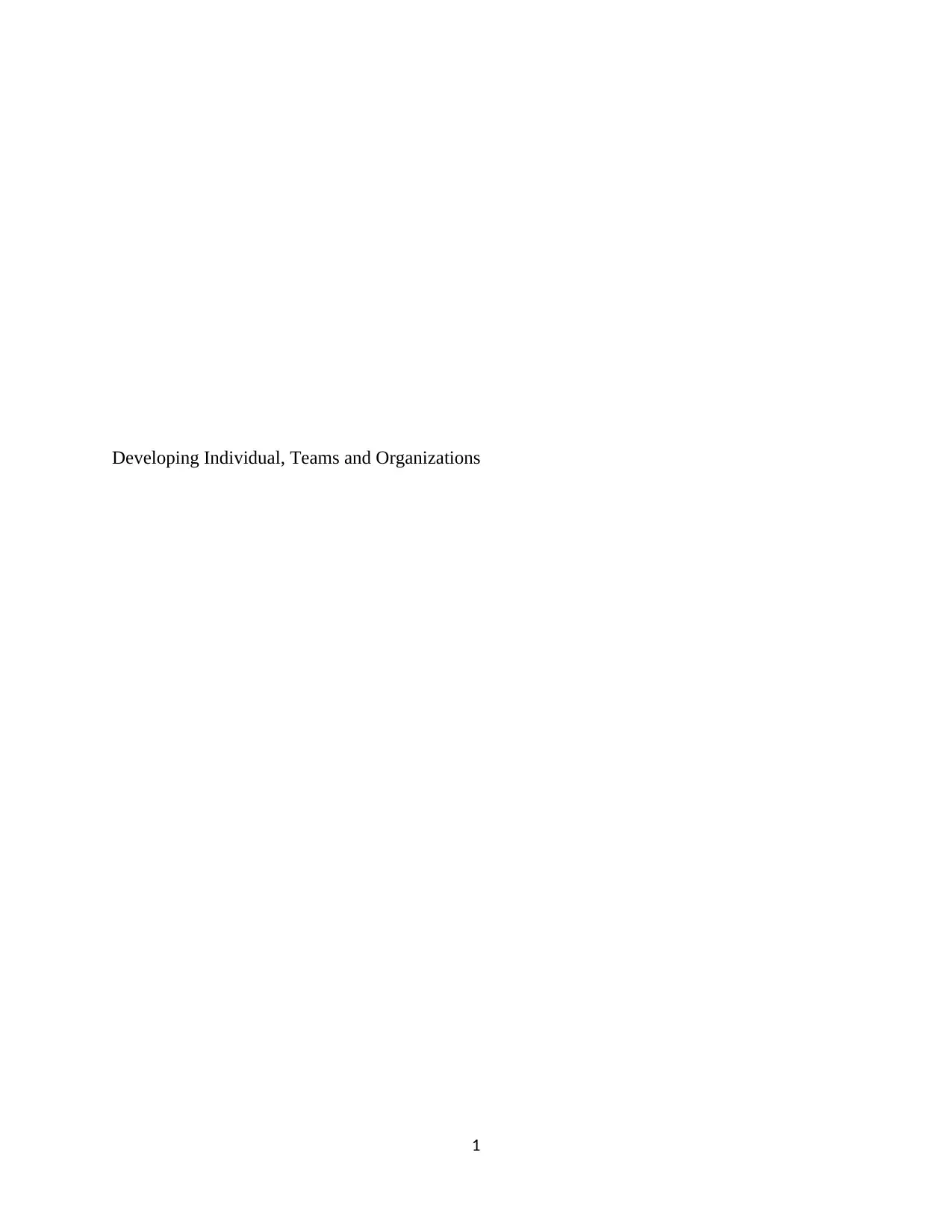
Developing Individual, Teams and Organizations
1
1
Paraphrase This Document
Need a fresh take? Get an instant paraphrase of this document with our AI Paraphraser
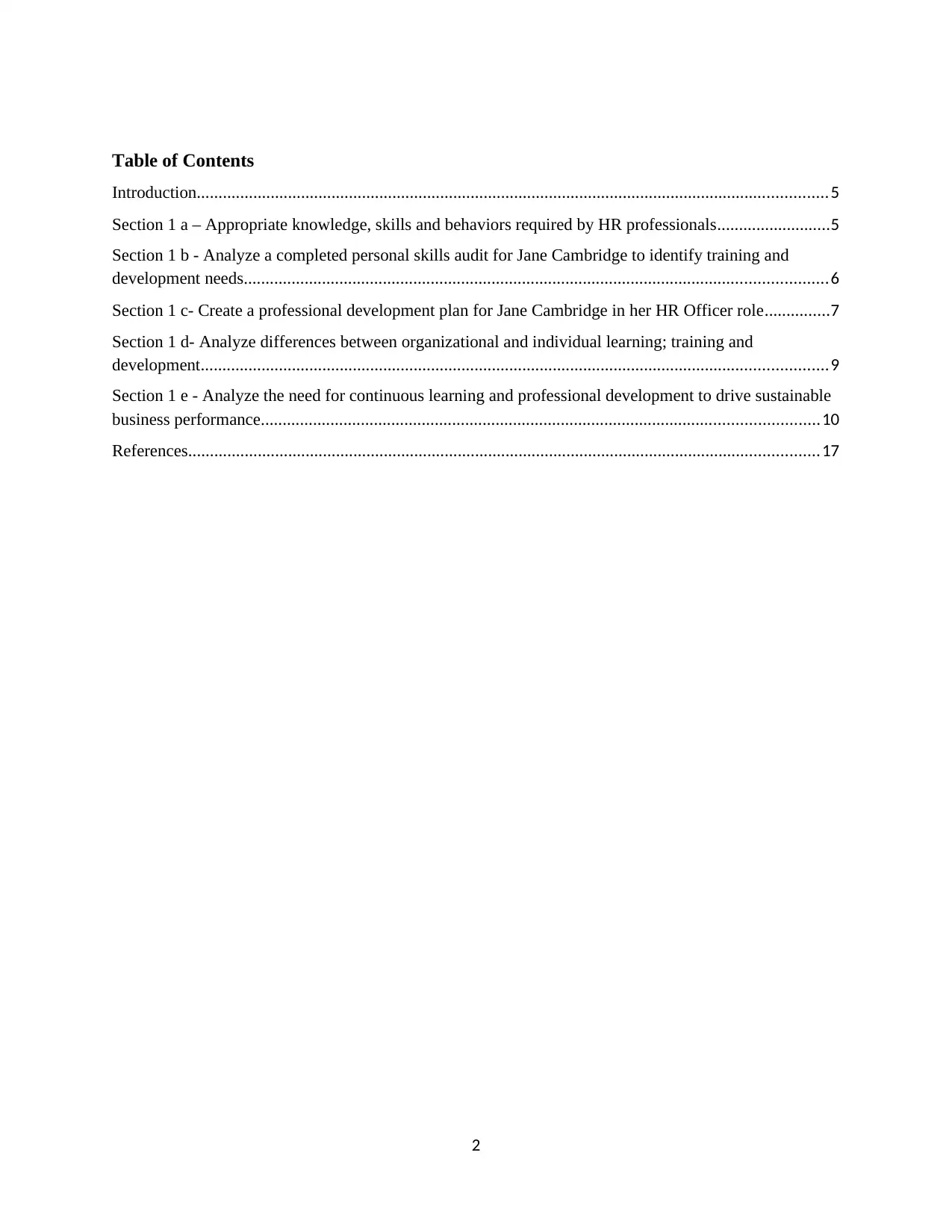
Table of Contents
Introduction.................................................................................................................................................5
Section 1 a – Appropriate knowledge, skills and behaviors required by HR professionals..........................5
Section 1 b - Analyze a completed personal skills audit for Jane Cambridge to identify training and
development needs......................................................................................................................................6
Section 1 c- Create a professional development plan for Jane Cambridge in her HR Officer role...............7
Section 1 d- Analyze differences between organizational and individual learning; training and
development................................................................................................................................................9
Section 1 e - Analyze the need for continuous learning and professional development to drive sustainable
business performance................................................................................................................................10
References.................................................................................................................................................17
2
Introduction.................................................................................................................................................5
Section 1 a – Appropriate knowledge, skills and behaviors required by HR professionals..........................5
Section 1 b - Analyze a completed personal skills audit for Jane Cambridge to identify training and
development needs......................................................................................................................................6
Section 1 c- Create a professional development plan for Jane Cambridge in her HR Officer role...............7
Section 1 d- Analyze differences between organizational and individual learning; training and
development................................................................................................................................................9
Section 1 e - Analyze the need for continuous learning and professional development to drive sustainable
business performance................................................................................................................................10
References.................................................................................................................................................17
2
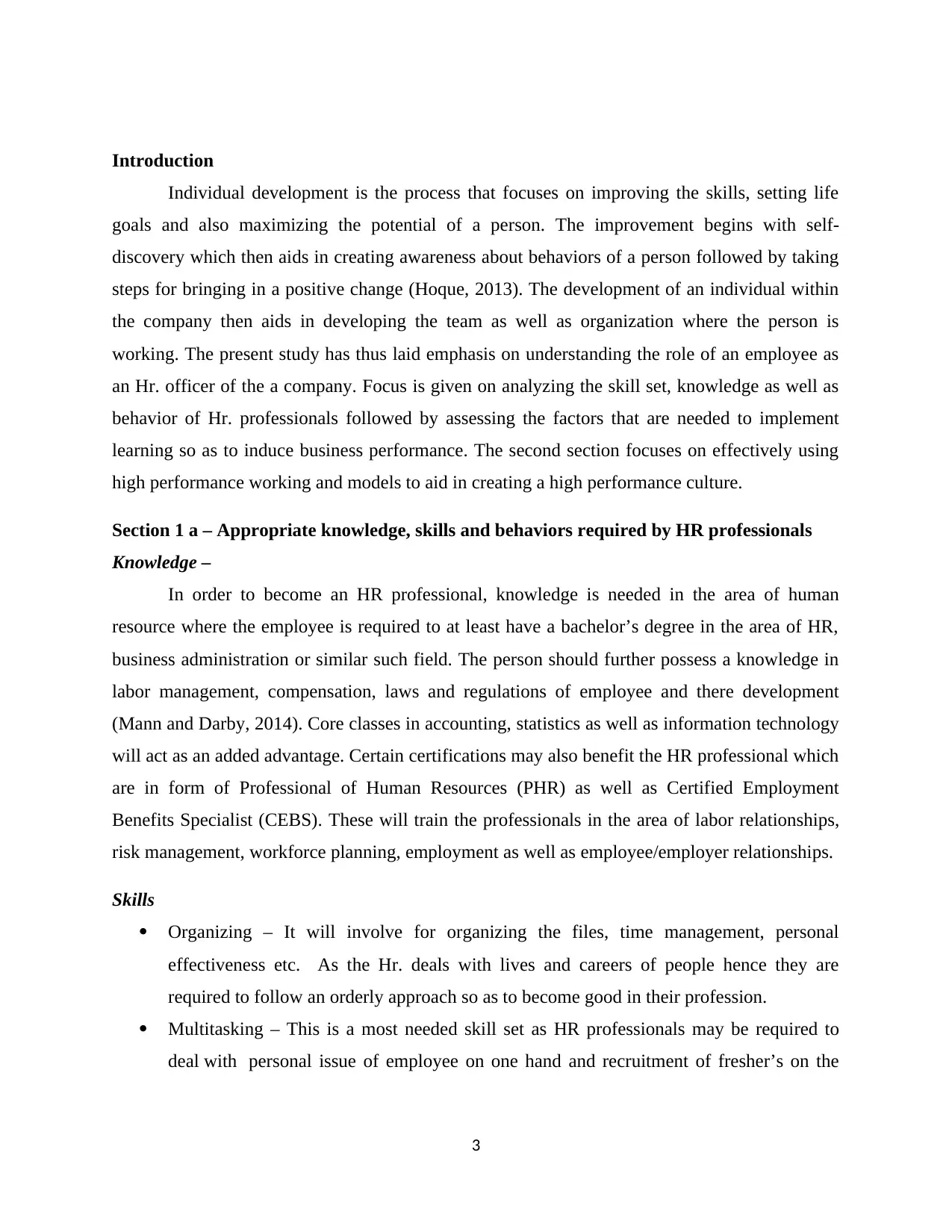
Introduction
Individual development is the process that focuses on improving the skills, setting life
goals and also maximizing the potential of a person. The improvement begins with self-
discovery which then aids in creating awareness about behaviors of a person followed by taking
steps for bringing in a positive change (Hoque, 2013). The development of an individual within
the company then aids in developing the team as well as organization where the person is
working. The present study has thus laid emphasis on understanding the role of an employee as
an Hr. officer of the a company. Focus is given on analyzing the skill set, knowledge as well as
behavior of Hr. professionals followed by assessing the factors that are needed to implement
learning so as to induce business performance. The second section focuses on effectively using
high performance working and models to aid in creating a high performance culture.
Section 1 a – Appropriate knowledge, skills and behaviors required by HR professionals
Knowledge –
In order to become an HR professional, knowledge is needed in the area of human
resource where the employee is required to at least have a bachelor’s degree in the area of HR,
business administration or similar such field. The person should further possess a knowledge in
labor management, compensation, laws and regulations of employee and there development
(Mann and Darby, 2014). Core classes in accounting, statistics as well as information technology
will act as an added advantage. Certain certifications may also benefit the HR professional which
are in form of Professional of Human Resources (PHR) as well as Certified Employment
Benefits Specialist (CEBS). These will train the professionals in the area of labor relationships,
risk management, workforce planning, employment as well as employee/employer relationships.
Skills
Organizing – It will involve for organizing the files, time management, personal
effectiveness etc. As the Hr. deals with lives and careers of people hence they are
required to follow an orderly approach so as to become good in their profession.
Multitasking – This is a most needed skill set as HR professionals may be required to
deal with personal issue of employee on one hand and recruitment of fresher’s on the
3
Individual development is the process that focuses on improving the skills, setting life
goals and also maximizing the potential of a person. The improvement begins with self-
discovery which then aids in creating awareness about behaviors of a person followed by taking
steps for bringing in a positive change (Hoque, 2013). The development of an individual within
the company then aids in developing the team as well as organization where the person is
working. The present study has thus laid emphasis on understanding the role of an employee as
an Hr. officer of the a company. Focus is given on analyzing the skill set, knowledge as well as
behavior of Hr. professionals followed by assessing the factors that are needed to implement
learning so as to induce business performance. The second section focuses on effectively using
high performance working and models to aid in creating a high performance culture.
Section 1 a – Appropriate knowledge, skills and behaviors required by HR professionals
Knowledge –
In order to become an HR professional, knowledge is needed in the area of human
resource where the employee is required to at least have a bachelor’s degree in the area of HR,
business administration or similar such field. The person should further possess a knowledge in
labor management, compensation, laws and regulations of employee and there development
(Mann and Darby, 2014). Core classes in accounting, statistics as well as information technology
will act as an added advantage. Certain certifications may also benefit the HR professional which
are in form of Professional of Human Resources (PHR) as well as Certified Employment
Benefits Specialist (CEBS). These will train the professionals in the area of labor relationships,
risk management, workforce planning, employment as well as employee/employer relationships.
Skills
Organizing – It will involve for organizing the files, time management, personal
effectiveness etc. As the Hr. deals with lives and careers of people hence they are
required to follow an orderly approach so as to become good in their profession.
Multitasking – This is a most needed skill set as HR professionals may be required to
deal with personal issue of employee on one hand and recruitment of fresher’s on the
3
⊘ This is a preview!⊘
Do you want full access?
Subscribe today to unlock all pages.

Trusted by 1+ million students worldwide
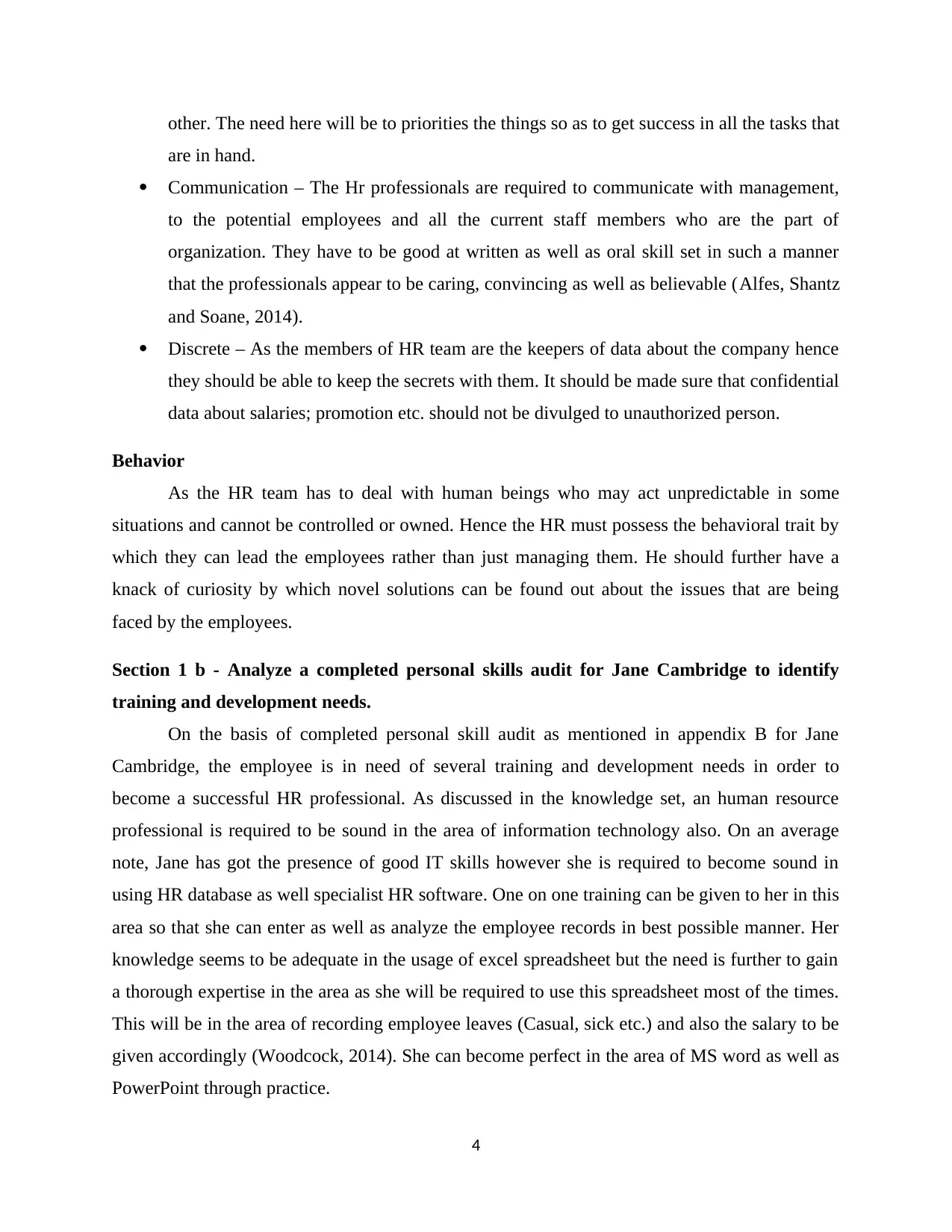
other. The need here will be to priorities the things so as to get success in all the tasks that
are in hand.
Communication – The Hr professionals are required to communicate with management,
to the potential employees and all the current staff members who are the part of
organization. They have to be good at written as well as oral skill set in such a manner
that the professionals appear to be caring, convincing as well as believable (Alfes, Shantz
and Soane, 2014).
Discrete – As the members of HR team are the keepers of data about the company hence
they should be able to keep the secrets with them. It should be made sure that confidential
data about salaries; promotion etc. should not be divulged to unauthorized person.
Behavior
As the HR team has to deal with human beings who may act unpredictable in some
situations and cannot be controlled or owned. Hence the HR must possess the behavioral trait by
which they can lead the employees rather than just managing them. He should further have a
knack of curiosity by which novel solutions can be found out about the issues that are being
faced by the employees.
Section 1 b - Analyze a completed personal skills audit for Jane Cambridge to identify
training and development needs.
On the basis of completed personal skill audit as mentioned in appendix B for Jane
Cambridge, the employee is in need of several training and development needs in order to
become a successful HR professional. As discussed in the knowledge set, an human resource
professional is required to be sound in the area of information technology also. On an average
note, Jane has got the presence of good IT skills however she is required to become sound in
using HR database as well specialist HR software. One on one training can be given to her in this
area so that she can enter as well as analyze the employee records in best possible manner. Her
knowledge seems to be adequate in the usage of excel spreadsheet but the need is further to gain
a thorough expertise in the area as she will be required to use this spreadsheet most of the times.
This will be in the area of recording employee leaves (Casual, sick etc.) and also the salary to be
given accordingly (Woodcock, 2014). She can become perfect in the area of MS word as well as
PowerPoint through practice.
4
are in hand.
Communication – The Hr professionals are required to communicate with management,
to the potential employees and all the current staff members who are the part of
organization. They have to be good at written as well as oral skill set in such a manner
that the professionals appear to be caring, convincing as well as believable (Alfes, Shantz
and Soane, 2014).
Discrete – As the members of HR team are the keepers of data about the company hence
they should be able to keep the secrets with them. It should be made sure that confidential
data about salaries; promotion etc. should not be divulged to unauthorized person.
Behavior
As the HR team has to deal with human beings who may act unpredictable in some
situations and cannot be controlled or owned. Hence the HR must possess the behavioral trait by
which they can lead the employees rather than just managing them. He should further have a
knack of curiosity by which novel solutions can be found out about the issues that are being
faced by the employees.
Section 1 b - Analyze a completed personal skills audit for Jane Cambridge to identify
training and development needs.
On the basis of completed personal skill audit as mentioned in appendix B for Jane
Cambridge, the employee is in need of several training and development needs in order to
become a successful HR professional. As discussed in the knowledge set, an human resource
professional is required to be sound in the area of information technology also. On an average
note, Jane has got the presence of good IT skills however she is required to become sound in
using HR database as well specialist HR software. One on one training can be given to her in this
area so that she can enter as well as analyze the employee records in best possible manner. Her
knowledge seems to be adequate in the usage of excel spreadsheet but the need is further to gain
a thorough expertise in the area as she will be required to use this spreadsheet most of the times.
This will be in the area of recording employee leaves (Casual, sick etc.) and also the salary to be
given accordingly (Woodcock, 2014). She can become perfect in the area of MS word as well as
PowerPoint through practice.
4
Paraphrase This Document
Need a fresh take? Get an instant paraphrase of this document with our AI Paraphraser

As discussed above, communication skill is also most needed in Hr professionals. Hence,
Jane is required to gain expertise in both oral as well as written expertise. The written
communication will aid her in drafting the employment contract in proper manner where she has
got the presence of little or no experience. Oral communication is required to be improved in
delivering a training session to the employees which is an entirely new area for Jane and hence is
required to be trained properly.
Another needed skill set is of problem solving in which Jane is better as compared to
communication skill. Still she is required to gain an expertise in handling complex data, using
information in selective manner as well as verbal reasoning skills. This area will help her in the
long run to become a good HR manager hence she should be trained properly in this area (Mann
and Darby, 2014).
Section 1 c- Create a professional development plan for Jane Cambridge in her HR Officer
role
What are the
developmental
objectives of
Jane
Cambridge
What activities are
needed to attain the
objectives
What support
resources are
required
Target date
for
achievement
of objective
How to evaluate objective
achievement
Excel
spreadsheet and
database
Practical training
session by an Excel
and database expert
Regular practice is
required to be done
by Jane on Excel
Refer to internet in
case of queries
Notebook for
writing notes
during training
session
Laptop with
advanced version
of Excel software
Trainer
3 months Able to do complex excel
calculations with ease
Able to guide new recruits in
usage of excel software and
database
Make proper entries in HR
database without any guidance
5
Jane is required to gain expertise in both oral as well as written expertise. The written
communication will aid her in drafting the employment contract in proper manner where she has
got the presence of little or no experience. Oral communication is required to be improved in
delivering a training session to the employees which is an entirely new area for Jane and hence is
required to be trained properly.
Another needed skill set is of problem solving in which Jane is better as compared to
communication skill. Still she is required to gain an expertise in handling complex data, using
information in selective manner as well as verbal reasoning skills. This area will help her in the
long run to become a good HR manager hence she should be trained properly in this area (Mann
and Darby, 2014).
Section 1 c- Create a professional development plan for Jane Cambridge in her HR Officer
role
What are the
developmental
objectives of
Jane
Cambridge
What activities are
needed to attain the
objectives
What support
resources are
required
Target date
for
achievement
of objective
How to evaluate objective
achievement
Excel
spreadsheet and
database
Practical training
session by an Excel
and database expert
Regular practice is
required to be done
by Jane on Excel
Refer to internet in
case of queries
Notebook for
writing notes
during training
session
Laptop with
advanced version
of Excel software
Trainer
3 months Able to do complex excel
calculations with ease
Able to guide new recruits in
usage of excel software and
database
Make proper entries in HR
database without any guidance
5

Specialist HR
software
One on one training
session by senior Hr
employee
Regular practice
towards usage of
software
Trainer
Laptop
2 months Able to use the Specialist software
effectively without making any big
blunders
Drafting
employment
contracts
Gaining knowledge
about what is an
employment contract
through internet and
company notes
Discussing queries
with senior
professionals
Preparing subsections
of contracts under the
guidance of senior
officials
Trainer
Internet
Company notes on
employment
contract
MS Word software
to frame sub
sections of contract
2 months Gain thorough understanding
about the nature of employment
contract
Able to devise contract with ease
and without guidance
Able to explain contract to the new
recruits if the need arises
Delivering a
training session
Briefing about need
and nature of training
sessions by senior HR
Accompanying trainer
in training session
Delivering small
portions of session
under guidance of
trainer
Referring to internet
and talking with
employee about
making improvement
Trainer
Internet
4 months Able to deliver independent
training sessions
Positive comments from seniors
and other employees
Increase in employee performance
after training has been delivered
6
software
One on one training
session by senior Hr
employee
Regular practice
towards usage of
software
Trainer
Laptop
2 months Able to use the Specialist software
effectively without making any big
blunders
Drafting
employment
contracts
Gaining knowledge
about what is an
employment contract
through internet and
company notes
Discussing queries
with senior
professionals
Preparing subsections
of contracts under the
guidance of senior
officials
Trainer
Internet
Company notes on
employment
contract
MS Word software
to frame sub
sections of contract
2 months Gain thorough understanding
about the nature of employment
contract
Able to devise contract with ease
and without guidance
Able to explain contract to the new
recruits if the need arises
Delivering a
training session
Briefing about need
and nature of training
sessions by senior HR
Accompanying trainer
in training session
Delivering small
portions of session
under guidance of
trainer
Referring to internet
and talking with
employee about
making improvement
Trainer
Internet
4 months Able to deliver independent
training sessions
Positive comments from seniors
and other employees
Increase in employee performance
after training has been delivered
6
⊘ This is a preview!⊘
Do you want full access?
Subscribe today to unlock all pages.

Trusted by 1+ million students worldwide
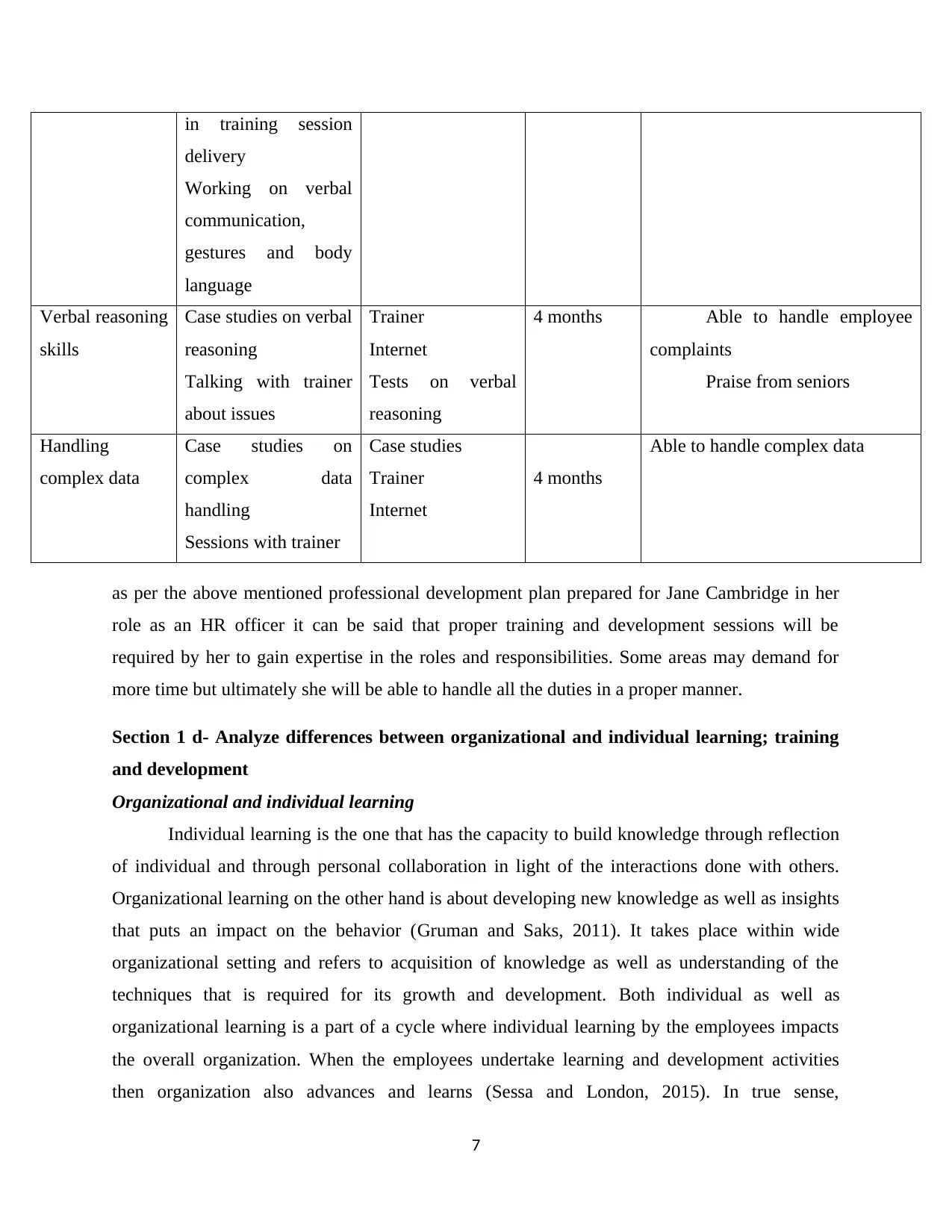
in training session
delivery
Working on verbal
communication,
gestures and body
language
Verbal reasoning
skills
Case studies on verbal
reasoning
Talking with trainer
about issues
Trainer
Internet
Tests on verbal
reasoning
4 months Able to handle employee
complaints
Praise from seniors
Handling
complex data
Case studies on
complex data
handling
Sessions with trainer
Case studies
Trainer
Internet
4 months
Able to handle complex data
as per the above mentioned professional development plan prepared for Jane Cambridge in her
role as an HR officer it can be said that proper training and development sessions will be
required by her to gain expertise in the roles and responsibilities. Some areas may demand for
more time but ultimately she will be able to handle all the duties in a proper manner.
Section 1 d- Analyze differences between organizational and individual learning; training
and development
Organizational and individual learning
Individual learning is the one that has the capacity to build knowledge through reflection
of individual and through personal collaboration in light of the interactions done with others.
Organizational learning on the other hand is about developing new knowledge as well as insights
that puts an impact on the behavior (Gruman and Saks, 2011). It takes place within wide
organizational setting and refers to acquisition of knowledge as well as understanding of the
techniques that is required for its growth and development. Both individual as well as
organizational learning is a part of a cycle where individual learning by the employees impacts
the overall organization. When the employees undertake learning and development activities
then organization also advances and learns (Sessa and London, 2015). In true sense,
7
delivery
Working on verbal
communication,
gestures and body
language
Verbal reasoning
skills
Case studies on verbal
reasoning
Talking with trainer
about issues
Trainer
Internet
Tests on verbal
reasoning
4 months Able to handle employee
complaints
Praise from seniors
Handling
complex data
Case studies on
complex data
handling
Sessions with trainer
Case studies
Trainer
Internet
4 months
Able to handle complex data
as per the above mentioned professional development plan prepared for Jane Cambridge in her
role as an HR officer it can be said that proper training and development sessions will be
required by her to gain expertise in the roles and responsibilities. Some areas may demand for
more time but ultimately she will be able to handle all the duties in a proper manner.
Section 1 d- Analyze differences between organizational and individual learning; training
and development
Organizational and individual learning
Individual learning is the one that has the capacity to build knowledge through reflection
of individual and through personal collaboration in light of the interactions done with others.
Organizational learning on the other hand is about developing new knowledge as well as insights
that puts an impact on the behavior (Gruman and Saks, 2011). It takes place within wide
organizational setting and refers to acquisition of knowledge as well as understanding of the
techniques that is required for its growth and development. Both individual as well as
organizational learning is a part of a cycle where individual learning by the employees impacts
the overall organization. When the employees undertake learning and development activities
then organization also advances and learns (Sessa and London, 2015). In true sense,
7
Paraphrase This Document
Need a fresh take? Get an instant paraphrase of this document with our AI Paraphraser
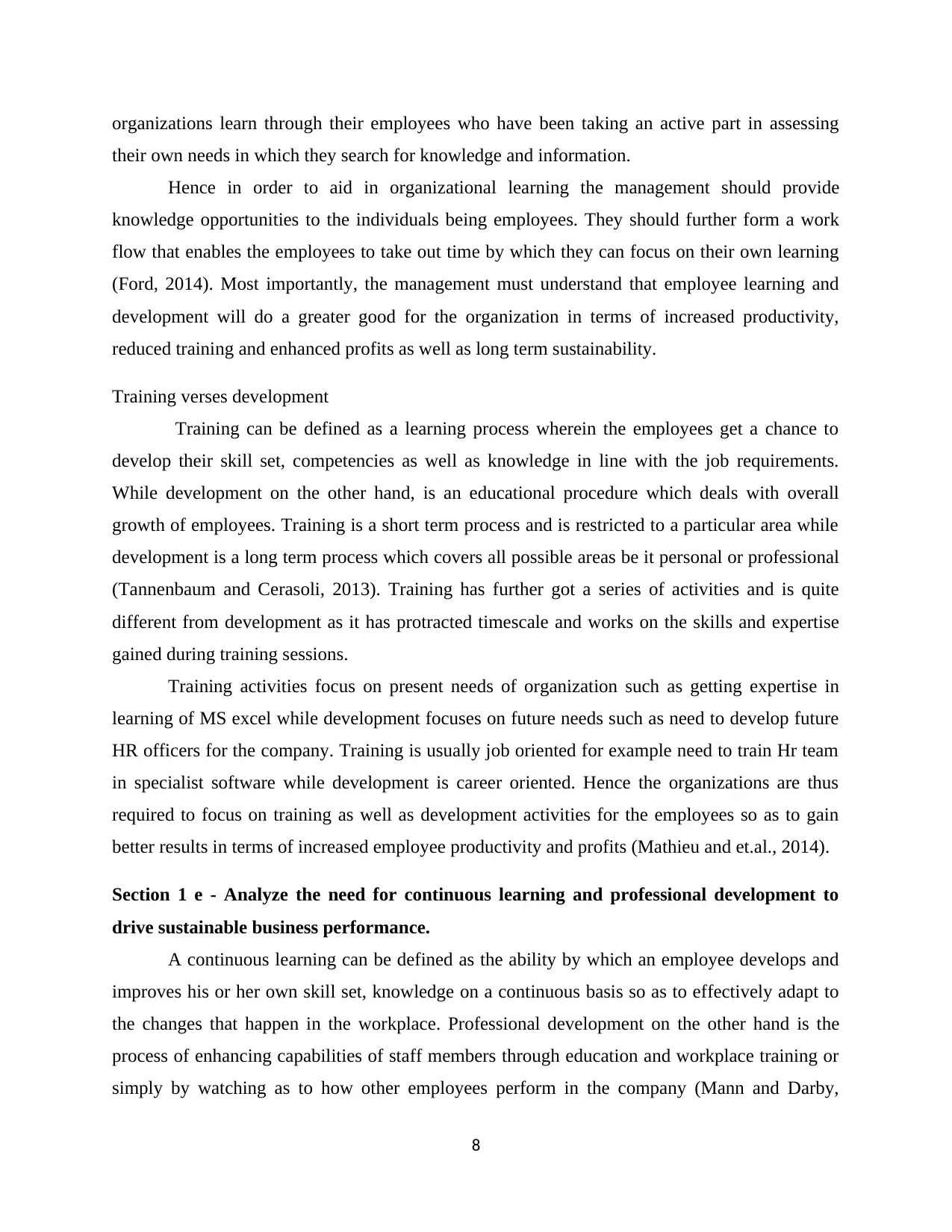
organizations learn through their employees who have been taking an active part in assessing
their own needs in which they search for knowledge and information.
Hence in order to aid in organizational learning the management should provide
knowledge opportunities to the individuals being employees. They should further form a work
flow that enables the employees to take out time by which they can focus on their own learning
(Ford, 2014). Most importantly, the management must understand that employee learning and
development will do a greater good for the organization in terms of increased productivity,
reduced training and enhanced profits as well as long term sustainability.
Training verses development
Training can be defined as a learning process wherein the employees get a chance to
develop their skill set, competencies as well as knowledge in line with the job requirements.
While development on the other hand, is an educational procedure which deals with overall
growth of employees. Training is a short term process and is restricted to a particular area while
development is a long term process which covers all possible areas be it personal or professional
(Tannenbaum and Cerasoli, 2013). Training has further got a series of activities and is quite
different from development as it has protracted timescale and works on the skills and expertise
gained during training sessions.
Training activities focus on present needs of organization such as getting expertise in
learning of MS excel while development focuses on future needs such as need to develop future
HR officers for the company. Training is usually job oriented for example need to train Hr team
in specialist software while development is career oriented. Hence the organizations are thus
required to focus on training as well as development activities for the employees so as to gain
better results in terms of increased employee productivity and profits (Mathieu and et.al., 2014).
Section 1 e - Analyze the need for continuous learning and professional development to
drive sustainable business performance.
A continuous learning can be defined as the ability by which an employee develops and
improves his or her own skill set, knowledge on a continuous basis so as to effectively adapt to
the changes that happen in the workplace. Professional development on the other hand is the
process of enhancing capabilities of staff members through education and workplace training or
simply by watching as to how other employees perform in the company (Mann and Darby,
8
their own needs in which they search for knowledge and information.
Hence in order to aid in organizational learning the management should provide
knowledge opportunities to the individuals being employees. They should further form a work
flow that enables the employees to take out time by which they can focus on their own learning
(Ford, 2014). Most importantly, the management must understand that employee learning and
development will do a greater good for the organization in terms of increased productivity,
reduced training and enhanced profits as well as long term sustainability.
Training verses development
Training can be defined as a learning process wherein the employees get a chance to
develop their skill set, competencies as well as knowledge in line with the job requirements.
While development on the other hand, is an educational procedure which deals with overall
growth of employees. Training is a short term process and is restricted to a particular area while
development is a long term process which covers all possible areas be it personal or professional
(Tannenbaum and Cerasoli, 2013). Training has further got a series of activities and is quite
different from development as it has protracted timescale and works on the skills and expertise
gained during training sessions.
Training activities focus on present needs of organization such as getting expertise in
learning of MS excel while development focuses on future needs such as need to develop future
HR officers for the company. Training is usually job oriented for example need to train Hr team
in specialist software while development is career oriented. Hence the organizations are thus
required to focus on training as well as development activities for the employees so as to gain
better results in terms of increased employee productivity and profits (Mathieu and et.al., 2014).
Section 1 e - Analyze the need for continuous learning and professional development to
drive sustainable business performance.
A continuous learning can be defined as the ability by which an employee develops and
improves his or her own skill set, knowledge on a continuous basis so as to effectively adapt to
the changes that happen in the workplace. Professional development on the other hand is the
process of enhancing capabilities of staff members through education and workplace training or
simply by watching as to how other employees perform in the company (Mann and Darby,
8

2014). The concept of continued learning as well as professional development is not only
advantageous for the employee but for the organization as well where the person is working.
This is because as the learning curve of employee increases he or she becomes more productive
in terms of delivering good performance (Consiglio and et.al., 2013). He also becomes happier
ad thus spreads the same atmosphere in overall workplace which increases the chances of overall
employee retention (Maynard and Gilson, 2014). All this benefits the company as they do not
have to focus on increased training and development for the employee. The presence of positive
work culture itself helps in improving the retention rates which increases the overall performance
of organization.
Essay on ‘Effective use of high-performance working (HPW) framework and performance
management models to support high performance culture’
United Kingdom commission for employment and skills defines high performance
working as a general approach that aids in managing firms and involving the employees in an
effective manner. It further focuses on making them work with increased commitment so as to
attain high level of performance (International approaches to high performance working, 2011).
The present essay has thus made an attempt to analyze how effective usage of high performance
working framework and performance management models aids in supporting culture where
increased work can be delivered. As per characteristics of HPW firms, they have got a clear and
well thought out strategic plan and employees act in a consistent manner so as to execute the
proposal (Tannenbaum and Cerasoli, 2013). The firms majorly follow consumer oriented
approach and the employees try to meet the expectation of customers which have already been
defined by the management. The managers further promote the employees to attain the best skill
set and knowledge to get work done and everyone has an idea about what is expected from them.
There is further a clear definition of performance measures which helps the employees to
perform the needed work. Research into effectiveness of HPW practices have revealed that there
is an increase in 20 to 40 percent firm productivity if it adopts these practices as compared to the
ones who do not (What is 'high performance working, 2016).
HPW practices in an organization further correlates to increased rate of organizational
growth, profitability, job satisfaction, decreased staff turnover, higher levels of innovation and
creativity in workplace. Most importantly, high performance teams have got an equation with
employee engagement which led to increased productivity. In this regard, how employees get
9
advantageous for the employee but for the organization as well where the person is working.
This is because as the learning curve of employee increases he or she becomes more productive
in terms of delivering good performance (Consiglio and et.al., 2013). He also becomes happier
ad thus spreads the same atmosphere in overall workplace which increases the chances of overall
employee retention (Maynard and Gilson, 2014). All this benefits the company as they do not
have to focus on increased training and development for the employee. The presence of positive
work culture itself helps in improving the retention rates which increases the overall performance
of organization.
Essay on ‘Effective use of high-performance working (HPW) framework and performance
management models to support high performance culture’
United Kingdom commission for employment and skills defines high performance
working as a general approach that aids in managing firms and involving the employees in an
effective manner. It further focuses on making them work with increased commitment so as to
attain high level of performance (International approaches to high performance working, 2011).
The present essay has thus made an attempt to analyze how effective usage of high performance
working framework and performance management models aids in supporting culture where
increased work can be delivered. As per characteristics of HPW firms, they have got a clear and
well thought out strategic plan and employees act in a consistent manner so as to execute the
proposal (Tannenbaum and Cerasoli, 2013). The firms majorly follow consumer oriented
approach and the employees try to meet the expectation of customers which have already been
defined by the management. The managers further promote the employees to attain the best skill
set and knowledge to get work done and everyone has an idea about what is expected from them.
There is further a clear definition of performance measures which helps the employees to
perform the needed work. Research into effectiveness of HPW practices have revealed that there
is an increase in 20 to 40 percent firm productivity if it adopts these practices as compared to the
ones who do not (What is 'high performance working, 2016).
HPW practices in an organization further correlates to increased rate of organizational
growth, profitability, job satisfaction, decreased staff turnover, higher levels of innovation and
creativity in workplace. Most importantly, high performance teams have got an equation with
employee engagement which led to increased productivity. In this regard, how employees get
9
⊘ This is a preview!⊘
Do you want full access?
Subscribe today to unlock all pages.

Trusted by 1+ million students worldwide
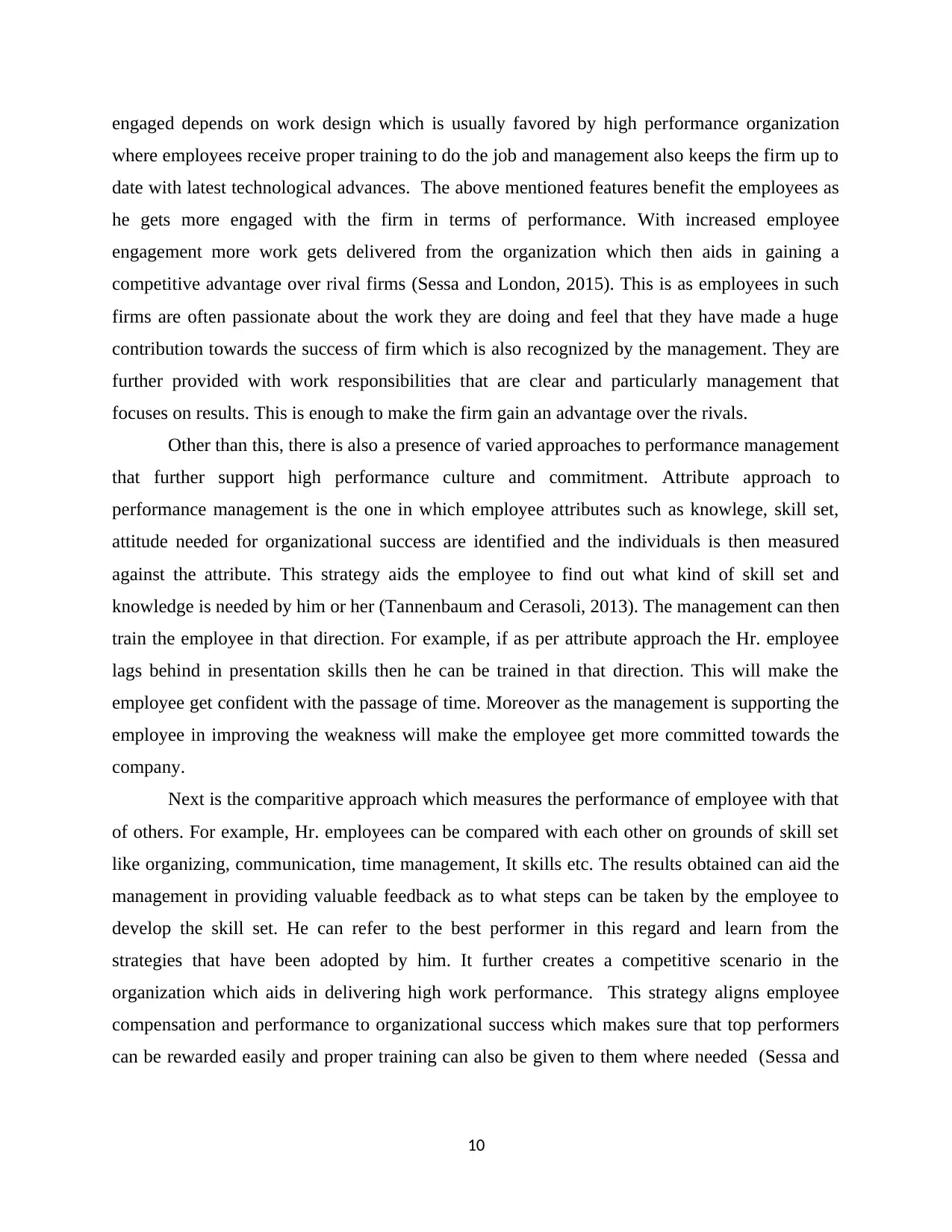
engaged depends on work design which is usually favored by high performance organization
where employees receive proper training to do the job and management also keeps the firm up to
date with latest technological advances. The above mentioned features benefit the employees as
he gets more engaged with the firm in terms of performance. With increased employee
engagement more work gets delivered from the organization which then aids in gaining a
competitive advantage over rival firms (Sessa and London, 2015). This is as employees in such
firms are often passionate about the work they are doing and feel that they have made a huge
contribution towards the success of firm which is also recognized by the management. They are
further provided with work responsibilities that are clear and particularly management that
focuses on results. This is enough to make the firm gain an advantage over the rivals.
Other than this, there is also a presence of varied approaches to performance management
that further support high performance culture and commitment. Attribute approach to
performance management is the one in which employee attributes such as knowlege, skill set,
attitude needed for organizational success are identified and the individuals is then measured
against the attribute. This strategy aids the employee to find out what kind of skill set and
knowledge is needed by him or her (Tannenbaum and Cerasoli, 2013). The management can then
train the employee in that direction. For example, if as per attribute approach the Hr. employee
lags behind in presentation skills then he can be trained in that direction. This will make the
employee get confident with the passage of time. Moreover as the management is supporting the
employee in improving the weakness will make the employee get more committed towards the
company.
Next is the comparitive approach which measures the performance of employee with that
of others. For example, Hr. employees can be compared with each other on grounds of skill set
like organizing, communication, time management, It skills etc. The results obtained can aid the
management in providing valuable feedback as to what steps can be taken by the employee to
develop the skill set. He can refer to the best performer in this regard and learn from the
strategies that have been adopted by him. It further creates a competitive scenario in the
organization which aids in delivering high work performance. This strategy aligns employee
compensation and performance to organizational success which makes sure that top performers
can be rewarded easily and proper training can also be given to them where needed (Sessa and
10
where employees receive proper training to do the job and management also keeps the firm up to
date with latest technological advances. The above mentioned features benefit the employees as
he gets more engaged with the firm in terms of performance. With increased employee
engagement more work gets delivered from the organization which then aids in gaining a
competitive advantage over rival firms (Sessa and London, 2015). This is as employees in such
firms are often passionate about the work they are doing and feel that they have made a huge
contribution towards the success of firm which is also recognized by the management. They are
further provided with work responsibilities that are clear and particularly management that
focuses on results. This is enough to make the firm gain an advantage over the rivals.
Other than this, there is also a presence of varied approaches to performance management
that further support high performance culture and commitment. Attribute approach to
performance management is the one in which employee attributes such as knowlege, skill set,
attitude needed for organizational success are identified and the individuals is then measured
against the attribute. This strategy aids the employee to find out what kind of skill set and
knowledge is needed by him or her (Tannenbaum and Cerasoli, 2013). The management can then
train the employee in that direction. For example, if as per attribute approach the Hr. employee
lags behind in presentation skills then he can be trained in that direction. This will make the
employee get confident with the passage of time. Moreover as the management is supporting the
employee in improving the weakness will make the employee get more committed towards the
company.
Next is the comparitive approach which measures the performance of employee with that
of others. For example, Hr. employees can be compared with each other on grounds of skill set
like organizing, communication, time management, It skills etc. The results obtained can aid the
management in providing valuable feedback as to what steps can be taken by the employee to
develop the skill set. He can refer to the best performer in this regard and learn from the
strategies that have been adopted by him. It further creates a competitive scenario in the
organization which aids in delivering high work performance. This strategy aligns employee
compensation and performance to organizational success which makes sure that top performers
can be rewarded easily and proper training can also be given to them where needed (Sessa and
10
Paraphrase This Document
Need a fresh take? Get an instant paraphrase of this document with our AI Paraphraser
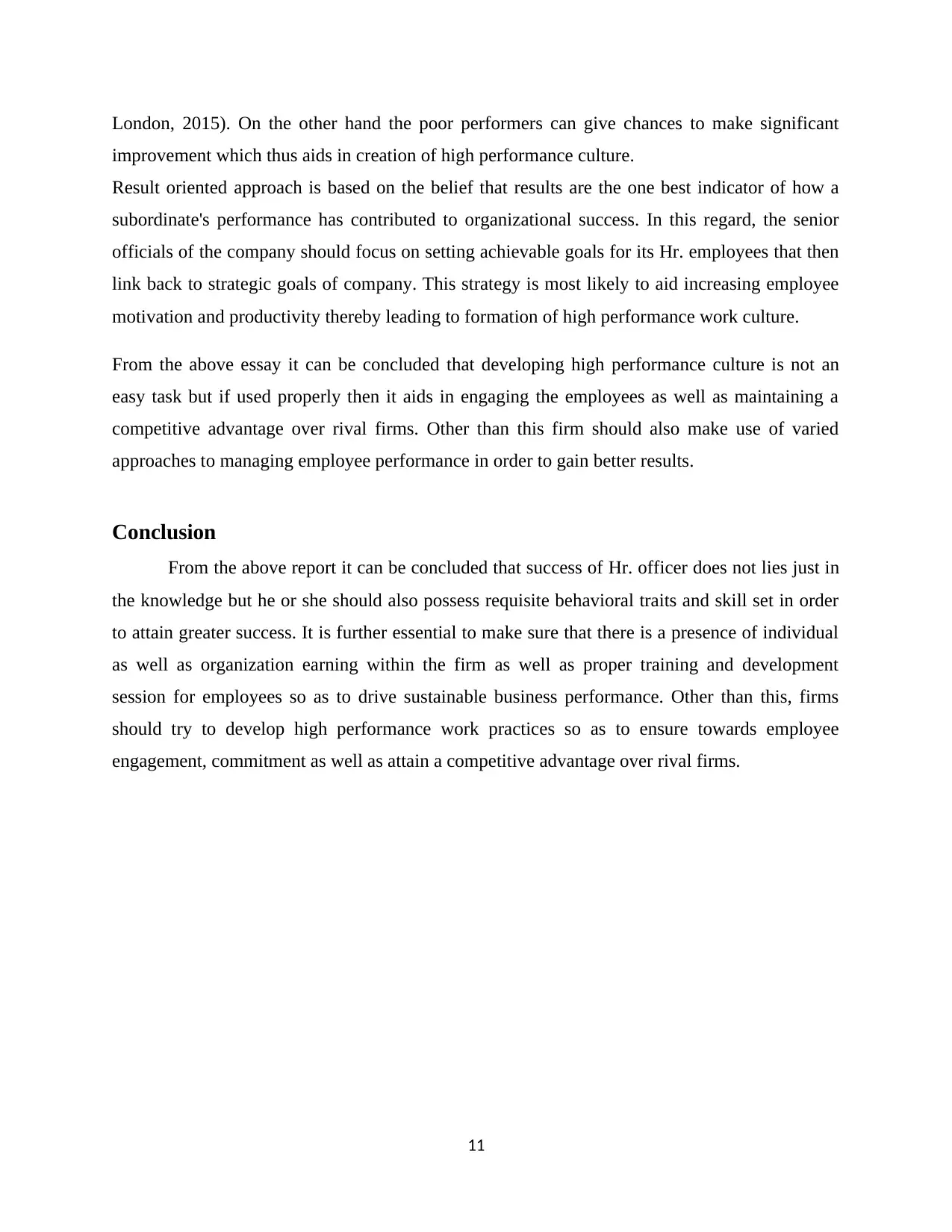
London, 2015). On the other hand the poor performers can give chances to make significant
improvement which thus aids in creation of high performance culture.
Result oriented approach is based on the belief that results are the one best indicator of how a
subordinate's performance has contributed to organizational success. In this regard, the senior
officials of the company should focus on setting achievable goals for its Hr. employees that then
link back to strategic goals of company. This strategy is most likely to aid increasing employee
motivation and productivity thereby leading to formation of high performance work culture.
From the above essay it can be concluded that developing high performance culture is not an
easy task but if used properly then it aids in engaging the employees as well as maintaining a
competitive advantage over rival firms. Other than this firm should also make use of varied
approaches to managing employee performance in order to gain better results.
Conclusion
From the above report it can be concluded that success of Hr. officer does not lies just in
the knowledge but he or she should also possess requisite behavioral traits and skill set in order
to attain greater success. It is further essential to make sure that there is a presence of individual
as well as organization earning within the firm as well as proper training and development
session for employees so as to drive sustainable business performance. Other than this, firms
should try to develop high performance work practices so as to ensure towards employee
engagement, commitment as well as attain a competitive advantage over rival firms.
11
improvement which thus aids in creation of high performance culture.
Result oriented approach is based on the belief that results are the one best indicator of how a
subordinate's performance has contributed to organizational success. In this regard, the senior
officials of the company should focus on setting achievable goals for its Hr. employees that then
link back to strategic goals of company. This strategy is most likely to aid increasing employee
motivation and productivity thereby leading to formation of high performance work culture.
From the above essay it can be concluded that developing high performance culture is not an
easy task but if used properly then it aids in engaging the employees as well as maintaining a
competitive advantage over rival firms. Other than this firm should also make use of varied
approaches to managing employee performance in order to gain better results.
Conclusion
From the above report it can be concluded that success of Hr. officer does not lies just in
the knowledge but he or she should also possess requisite behavioral traits and skill set in order
to attain greater success. It is further essential to make sure that there is a presence of individual
as well as organization earning within the firm as well as proper training and development
session for employees so as to drive sustainable business performance. Other than this, firms
should try to develop high performance work practices so as to ensure towards employee
engagement, commitment as well as attain a competitive advantage over rival firms.
11
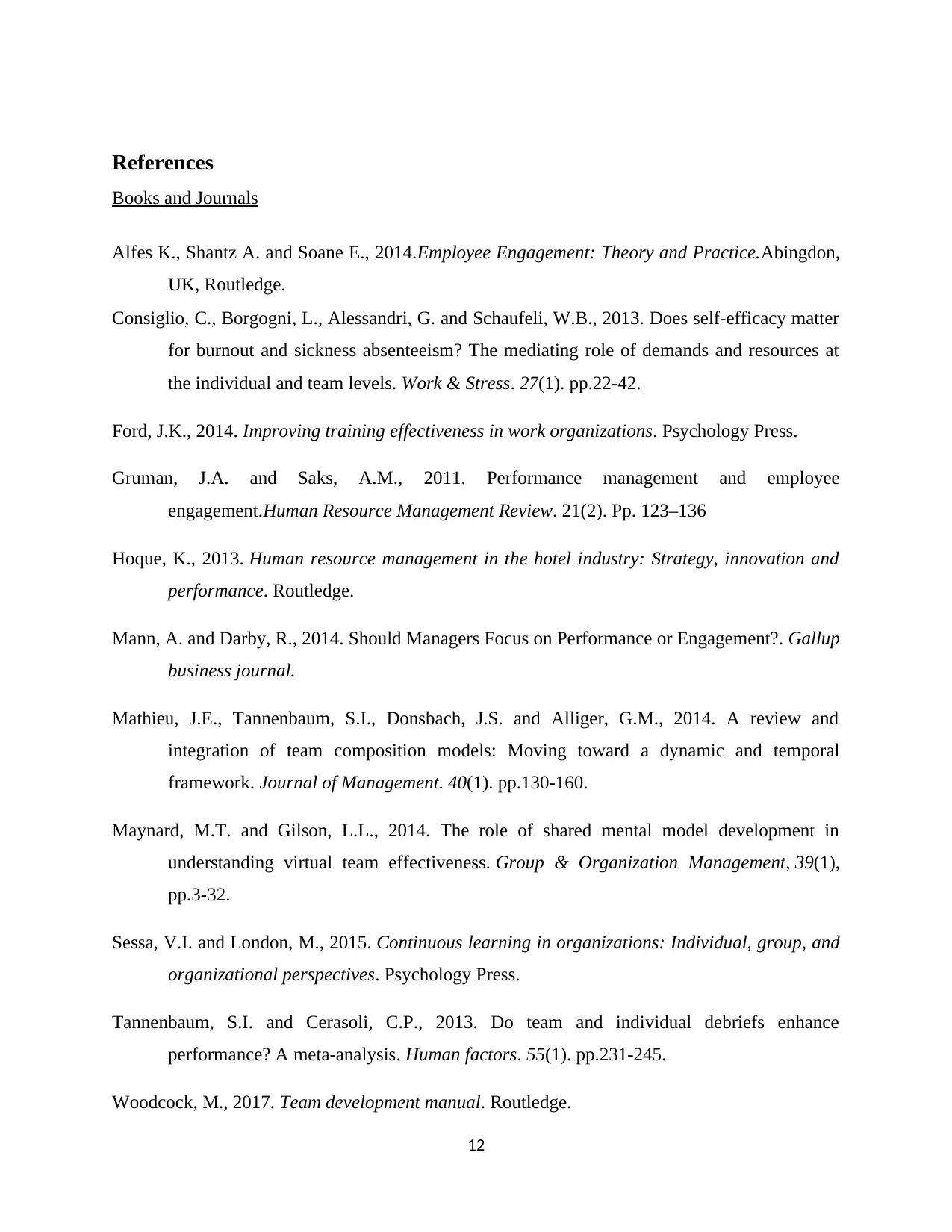
References
Books and Journals
Alfes K., Shantz A. and Soane E., 2014.Employee Engagement: Theory and Practice.Abingdon,
UK, Routledge.
Consiglio, C., Borgogni, L., Alessandri, G. and Schaufeli, W.B., 2013. Does self-efficacy matter
for burnout and sickness absenteeism? The mediating role of demands and resources at
the individual and team levels. Work & Stress. 27(1). pp.22-42.
Ford, J.K., 2014. Improving training effectiveness in work organizations. Psychology Press.
Gruman, J.A. and Saks, A.M., 2011. Performance management and employee
engagement.Human Resource Management Review. 21(2). Pp. 123–136
Hoque, K., 2013. Human resource management in the hotel industry: Strategy, innovation and
performance. Routledge.
Mann, A. and Darby, R., 2014. Should Managers Focus on Performance or Engagement?. Gallup
business journal.
Mathieu, J.E., Tannenbaum, S.I., Donsbach, J.S. and Alliger, G.M., 2014. A review and
integration of team composition models: Moving toward a dynamic and temporal
framework. Journal of Management. 40(1). pp.130-160.
Maynard, M.T. and Gilson, L.L., 2014. The role of shared mental model development in
understanding virtual team effectiveness. Group & Organization Management, 39(1),
pp.3-32.
Sessa, V.I. and London, M., 2015. Continuous learning in organizations: Individual, group, and
organizational perspectives. Psychology Press.
Tannenbaum, S.I. and Cerasoli, C.P., 2013. Do team and individual debriefs enhance
performance? A meta-analysis. Human factors. 55(1). pp.231-245.
Woodcock, M., 2017. Team development manual. Routledge.
12
Books and Journals
Alfes K., Shantz A. and Soane E., 2014.Employee Engagement: Theory and Practice.Abingdon,
UK, Routledge.
Consiglio, C., Borgogni, L., Alessandri, G. and Schaufeli, W.B., 2013. Does self-efficacy matter
for burnout and sickness absenteeism? The mediating role of demands and resources at
the individual and team levels. Work & Stress. 27(1). pp.22-42.
Ford, J.K., 2014. Improving training effectiveness in work organizations. Psychology Press.
Gruman, J.A. and Saks, A.M., 2011. Performance management and employee
engagement.Human Resource Management Review. 21(2). Pp. 123–136
Hoque, K., 2013. Human resource management in the hotel industry: Strategy, innovation and
performance. Routledge.
Mann, A. and Darby, R., 2014. Should Managers Focus on Performance or Engagement?. Gallup
business journal.
Mathieu, J.E., Tannenbaum, S.I., Donsbach, J.S. and Alliger, G.M., 2014. A review and
integration of team composition models: Moving toward a dynamic and temporal
framework. Journal of Management. 40(1). pp.130-160.
Maynard, M.T. and Gilson, L.L., 2014. The role of shared mental model development in
understanding virtual team effectiveness. Group & Organization Management, 39(1),
pp.3-32.
Sessa, V.I. and London, M., 2015. Continuous learning in organizations: Individual, group, and
organizational perspectives. Psychology Press.
Tannenbaum, S.I. and Cerasoli, C.P., 2013. Do team and individual debriefs enhance
performance? A meta-analysis. Human factors. 55(1). pp.231-245.
Woodcock, M., 2017. Team development manual. Routledge.
12
⊘ This is a preview!⊘
Do you want full access?
Subscribe today to unlock all pages.

Trusted by 1+ million students worldwide
1 out of 13
Related Documents
Your All-in-One AI-Powered Toolkit for Academic Success.
+13062052269
info@desklib.com
Available 24*7 on WhatsApp / Email
![[object Object]](/_next/static/media/star-bottom.7253800d.svg)
Unlock your academic potential
Copyright © 2020–2025 A2Z Services. All Rights Reserved. Developed and managed by ZUCOL.





